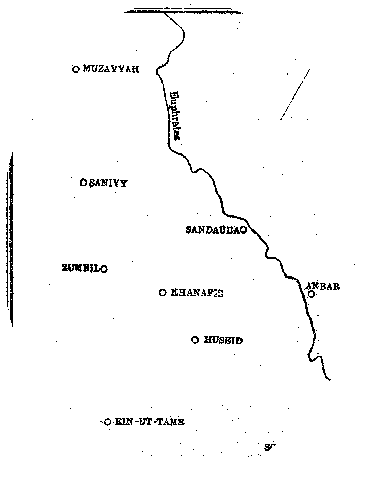|
"We attacked them with
mounted troops, and they saw
The darkness of death around those leafy gardens.
By morning they said we were a people who had swarmed
Over the fertile country from rugged Arabia."
[ Al-Qa'qa' bin Amr, commander in Khalid's army]1
Khalid had not gone from
Ain-ut-Tamr many days when word of his departure arrived at the
Persian court. It was believed that Khalid had returned to Arabia
with a large part of his army; and Ctesiphon breathed more easily.
After a few days, this mood of relief passed and was replaced by
an angry desire to throw the Muslims back into the desert and regain
the territories and the prestige which the Empire had lost. The
Persians had resolved not to fight Khalid again; but they were quite
prepared to fight the Muslims without Khalid.
Bahman set to work. By now he had organised
a new army, made up partly of the survivors of Ullais, partly of
veterans drawn from garrisons in other parts of the Empire, and
partly of fresh recruits. This army was now ready for battle. With
its numerous raw recruits, however, it was not of the same quality
as the armies which had fought Khalid south of the Euphrates. Bahman
decided not to commit this army to battle until its strength had
been augmented by the large forces of Christian Arabs who remained
loyal to the Empire. He therefore initiated parleys with the Arabs.
The Christian Arabs responded willingly
and eagerly to the overtures of the Persian court. Apart from the
defeat at Ain?ut-Tamr, the incensed Arabs of this area also sought
revenge for the killing of their great chief, Aqqa. They were anxious,
too, to regain the lands which they had lost to the Muslims, and
to free the comrades who had been captured by the invaders. A large
number of clans began to prepare for war.
Bahman divided the Persian forces into two
field armies and sent them off from Ctesiphon. One, under Ruzbeh,
moved to Husaid, and the other, under Zarmahr, moved to Khanafis.
For the moment these two armies were located in separate areas for
ease of movement and administration, but they were not to proceed
beyond these locations until the Christian Arabs were ready for
battle. Bahman planned to concentrate the entire imperial army to
either await a Muslim attack or march south to fight the Muslims
at Hira.
But the Christian Arabs were not yet ready.
They were forming into two groups: the first, under a chief named
Huzail bin Imran, was concentrating at Muzayyah; the second, under
the chief Rabi'a bin Bujair, was gathering at two places close to
each other-Saniyy and Zumail (which was also known as Bashar). These
two groups, when ready, would join the Persians and form one large,
powerful army. (See Map 14 below)

It was while these preparations were in
progress that Qaqa, commanding the Iraq front in the absence of
Khalid, took counter-measures. He pulled back some of the detachments
which Khalid had sent across the Euphrates and concentrated them
at Hira. And he sent two regiments forward-one to Husaid and the
other to Khanafis. The commanders of these regiments were ordered
to remain in contact with the Persian forces at these places, to
delay the advance of the Persians, should they decide to push forward,
and to keep Qaqa informed of Persian strengths and movements. These
regiments moved to their respective objectives and made contact
with the Persians. In the mean time, Qaqa kept the rest of the army
in readiness to take the field.
This was the situation that greeted Khalid
on his arrival at Hira in the fourth week of September 633 (middle
of Rajab, 12 Hijri). The situation could assume dangerous proportions,
but only if the four imperial forces succeeded in uniting and took
offensive action against Hira. Any plan that the Muslims adopted
would have to cater for two strategical requirements: (a) to prevent
the concentration of the imperial forces into one great, invincible
army, and (b) to guard Hira against the enemy in one sector while
the Muslims operated against the enemy in the other.
Khalid decided to fight the operation in
a way which had now become typical of him. He would take the offensive
and destroy each imperial force separately in situ. With this strategy
in mind, he divided the Muslim garrison of Hira into two corps,
one of which he placed under Qaqa and the other under Abu Laila.
Khalid sent them both to Ain-ut-Tamr, where he would join them a
little later, after the troops who had fought at Daumat-ul-Jandal
had been rested.
A few days later the entire Muslim army
was concentrated at Ain-ut-Tamr, except for a small garrison left
under Ayadh bin Ghanam to look after Hira. The army was now organised
in three corps of about 5,000 men each, one of which was kept in
reserve. Khalid sent Qaqa to Husaid and Abu Laila to Khanafis with
orders to destroy the Persian armies at those places. The two generals
were to take command of the Muslim regiments already deployed in
their respective sectors. It was Khalid's intention to fight both
Persian armies speedily as well as simultaneously, so that neither
could get away while the other was being slashed to pieces. But
this was not to be; for the march to Khanafis was longer than to
Husaid, and Abu Laila failed to move his forces with sufficient
speed to make up for this difference. Meanwhile Khalid remained
with his reserve corps at Ain-ut-Tamr to guard against any offensive
movement from Saniyy and Zumail towards Hira.
1. Ibn Kathir, Al-Bidayah wan-Nihayah, Dar
Abi Hayyan, Cairo, 1st ed. 1416/1996, vol. 6 p. 426.
|
